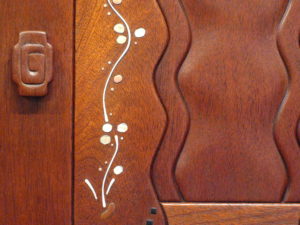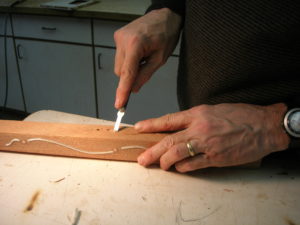Balance applies to the Greene brothers’ take on adorning their furniture

One of the details you see in the late work of the Greene brothers is decorative inlay design.
You won’t find these details in their earliest work. It’s something they developed over their mutual career.
As an
artist, I understand their interest and need to evolve their own style. Merging and blending details that elevate the beauty of one’s work is critical. In fact, if you look back at their early work, you wouldn’t recognize it as what we think of the Greene and Greene style today. It grew from being simple furniture into commissioned art.
The brothers’ style evolved to include inlay
The Greene brothers transitioned how they thought about decoration and structural significance starting with their furniture design at the Bolton and Robinson Houses, early large commissions in Pasadena, CA.
The Robinson House’s furniture is the best example of their move from the Stickley tradition of simple construction to their hybrid style of the same simplicity with added Asian influences. Previously, a furniture butterfly joint would have been a hidden functional element, but here they are exposed and celebrated as decorative flourishes. They were getting comfortable with decoration for the sake of it.
Use of pure decorative inlay began with the Ford House. After that, it was used extensively in the Blacker and Gamble Houses’ furniture and lighting. This represents the height of their use of inlay because these commissions allowed them the opportunity to create their works of art. By the time of the Blacker House, inlay was an integral and important element in their designs, and was used broadly throughout the house.
In the Blacker House you see sterling and copper vines linked with flowers of abalone shell. These elements were purely decorative in nature, and certainly extravagant when compared with their earlier furniture.
How to create decorative inlay
Incorporating these stylistic grace notes can be a little tricky. As with many details, it’s easy to get carried away with beautiful materials. The technique is simple, but requires some finesse.
Here’s how. Shape the inlay material to the specific design, be it a twist of copper wire
for a grapevine, or an oval of a shell for a flower face.

Carefully scribe outside the piece. Lift the piece off the base, and with a chisel or knife, remove enough of the base material within the outline so that the inlay will fit into the carved-out space, yet remain a bit above the surface of the base. This is another point of difference with the earlier Arts and Crafts tradition. Earlier inlaid elements were usually flush with the surface, to maintain the notion that they were structurally necessary components.
 Jeff in his studio creatingGreene and Greene-style inlay
Jeff in his studio creatingGreene and Greene-style inlay
Once the base is
prepared, the inlay material is set with epoxy. When the epoxy sets, the inlaid materials can be filed or shaped to fit the desired design. A finishing buff is all that’s left to make the piece shine.
